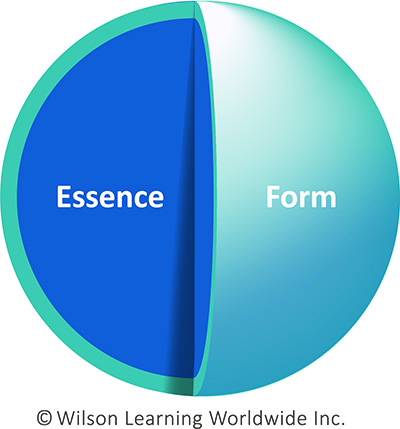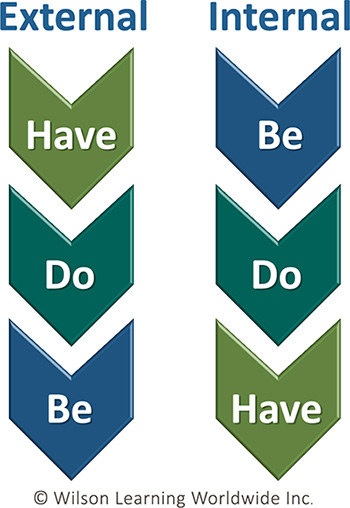Developing Great Leaders
Integrating Leadership Character and Skills (Point of View Paper)

An organization can have the right strategy, structure, systems, and processes in place, but to succeed, it still requires people to execute the strategy. The challenge to the organization’s leaders is to create an environment in which employees feel valued, engaged, and committed to executing that strategy.
What are organizations doing to develop leaders who can drive the organization forward and inspire individuals to follow? Most organizations say increasing leadership effectiveness is a high priority. However, many of those same organizations admit they are not very effective at developing great leaders.
In order to develop great leaders, you first have to answer the question: “What makes a great leader?” During the 40 years Wilson Learning has studied and implemented leadership development efforts, we have come to believe that how leaders view their purpose, and integrate skills and character, sets the course for their success.
The Purpose of a Leader
For Wilson Learning, the purpose of a leader is to engage others in committing their full energy to the creation of value and success. This statement contains important elements that are at the core of our leadership point of view:
- Engage others to commit their full energy. Leaders must understand they are in the energy business—specifically, the human energy business. You can’t “make” people be engaged; it is their choice to commit their energy. The leader’s role is to create the conditions in which others are committed to giving their full energy.
- Creation of value and success. Leaders need to help people commit their energy for the purpose of creating value for the organization by creating value for its customers and themselves. Only when employees feel they are contributing to their own value and success can they then contribute to the value and success of the company’s customers, in turn creating value and success for the organization.
Leaders who understand this purpose create the conditions necessary for employees to achieve high performance with a sense of personal fulfillment. Our research shows that both performance and fulfillment are essential to sustained high performance—people will not achieve sustained high performance without feeling fulfilled, and people will not feel fulfilled at work unless they perform at high levels. Helping organizations and individuals achieve performance with fulfillment has been Wilson Learning’s mission for more than 40 years.
Integrated Leadership: The Balance of Essence and Form

We have consistently observed that only leaders who have successfully integrated Essence and Form can fulfill their purpose—engaging others in committing their full energy to the creation of value and success.
Wilson Learning’s approach to assessing and developing leaders was created to tap both the Essence and Form of leadership. Essence is captured in what we call Leadership Character—those elements of leadership that are enduring and core to how people view the purpose of leadership. Essence is the philosophy, beliefs, values, and sense of purpose that guide who you want to BE as a leader, and it gives leaders their identity. Form, in contrast, represents those elements of leadership that adapt and change depending on a leader’s level and functional role. Form (Skills) are the things a leader does and says; it is what you need to DO as a leader, such as delegating, goal setting, and coaching. While distinct, both elements are essential to effective leadership.
The integration of Character and Skills (Essence and Form) is required for effectiveness at all levels of leadership. Many organizations think Character is only needed at the top level—that only those responsible for the overall organization are mature enough to take advantage of character development. Our experience indicates the most successful organizations recognize character development is critical to leaders at all levels and that the needs are different at each level.
Here, we introduce a leadership development framework that shows how different levels of leadership face different challenges. These different challenges influence how Essence and Form need to be developed in leaders today.
Profiles of Leadership
When organizations talk about developing leaders, they typically frame their discussions along three generally accepted levels:
- First-level leaders—Managers and supervisors of individual contributors
- Mid-level leaders—Managers of departments or functions, managers of managers
- Executive leaders—Executives responsible for the overall leadership and culture of the organization
How organizations develop these different levels of leadership varies widely, although most organizations focus on differences in leadership skills. That is, as you move to higher levels of leadership, you need to acquire additional, more complex, and strategic skills. While this is true, it is not the entire challenge of leadership development.
Our experience is that all leaders, regardless of level, need both Essence and Form (Character and Skills), but the specific requirements differ at each level. While these differences stem partly from the leader’s maturity, the primary distinctions are due to how each level of leader contributes to value and success.
Our Leadership Development Framework provides a structure for understanding leaders’ needs at different levels. Once each level’s distinct challenges and needs are understood, organizations can build paths to address specific skill and character development needs. Through this approach, the organization grows leaders who fulfill the purpose of leadership and integrate both Essence and Form.
The Leadership Development Framework
As the framework below shows, Essence and Form are integrated at all levels of leadership. For new leaders, Form (Skill) development influences success more than Essence, but Essence is still critical. As leaders mature, the importance of Essence grows until, by the time they reach the Executive level, it is the primary driver of success.

First-Level Leadership
First-level leadership is more about Form (Skill) without ignoring Essence (Character). First-level leaders are making a transition from being an individual contributor to leading the performance of others. This transition to contributing value by getting work done through others can be a difficult one. Until this point, as an individual contributor, this person was only responsible for his or her own performance. This person may have walked out on Friday as an individual contributor but walks in on Monday responsible for the performance of others—hopefully with the understanding that he or she can’t get the job done alone but needs to accomplish the job through others.
Thus, what is most important to a new first-level leader is quickly acquiring what we call Leadership Survival Skills. These skills help leaders transition to their new role and achieve early successes in guiding others. Key survival skills include the following:
- Motivating employees
- Communicating effectively
- Defining tasks and goals
- Delegating with confidence
- Observing behavior
- Providing feedback and coaching
- Resolving conflict
- Helping others solve problems
While survival skills encompass much of the development needs of first-level leaders, these leaders are also going through an Essence transformation. A first-level leader needs to begin establishing what he/she wants to be as a leader; we call this Establishing Leadership Credibility.
In most organizations, the majority of first-level leaders have gained their credibility and are promoted based on their technical expertise. High-performing salespeople become sales managers, high-performing accountants become accounting managers, and so on.
The natural tendency of new managers is to rely on their functional expertise to establish their credibility and to succeed as leaders. As a result, new managers often solve problems for their employees, rather than help employees learn how to solve problems themselves.
This approach does not help advance the team’s performance, so the challenge for new leaders is to rely less on functional credibility and instead earn credibility as a leader. Establishing leadership as a source of credibility requires new leaders to think about what they want to be as a leader. As a first-level leader, it is not too early to think about leadership philosophy and beliefs; in fact, it is essential, as it affects how they implement their survival skills.
New first-level leaders need the wisdom to make the transition from being just a technical expert to making leadership their source of credibility.
Mid-Level Leadership
While first-level leadership requires one-to-one survival skills, mid-level leadership includes more one-to-group, or team development, skills. Mid-level leaders need to shift their focus from getting work done through others toward getting work done with people, and they must do so in a way that grows others’ ability to do it themselves. This critical shift requires leaders to understand the importance of building capability in others, rather than being a Heroic Manager who controls or micromanages people.
Mid-level leadership skills center on Growth Skills—skills that help others grow their own capabilities and help the group or department grow as a whole. Growth skills include the following:

- Motivating employees through vision and mission
- Setting team goals and solving problems
- Defining outcomes and goals—providing task direction
- Delegating with confidence
- Providing feedback and coaching
- Resolving conflict
- Negotiating and collaborating cross-functionally
- Communicating effectively
- Helping others solve problems
- Facilitating collaboration
The role of Essence expands in mid-level leadership. While mid-level leaders need fewer new skills than first-level leaders, their need for character development (Essence) increases significantly. If the Essence transition for first-level leaders is to Establish Leadership Credibility, the Essence transition for mid-level leaders is to become a Purpose- and Values-Centered Leader.
This transition starts by understanding where leaders get the signals that guide them.
Moving into mid-level leadership is usually a big step, often including a meaningful increase in salary, large increase in responsibility, and greater span of control. As a result, many leaders start taking their signals from external sources. Their approach takes the form of Have-Do-Be: “I need to have the authority, so I can do more, so I can be successful.”
Effective mid-level leaders who have integrated Form and Essence take their signals from internal sources. Their approach flips to become Be-Do-Have: “I need to be a purpose-centered leader, which guides what I do as a leader, and only then will I have the sense of how to contribute to the success of others.”
For mid-level leaders who have developed Purpose-and Value-Centered Leadership Essence, depth of character becomes more important than appearance of power. They take action based on values, not on short-term gains. Success is measured by their contributions to others, not title or salary. And life is lived on purpose, not on approval from others.
This transition is critical for the organization’s success. Mid-level leaders are further removed from the organization’s doers, so these leaders create value for the organization by increasing the capabilities and capacity of others. Having this clear sense of Essence provides the foundation that makes their leadership skills (Form) effective.
Executive Leadership
By the time leaders reach the executive level, they have likely acquired most of the leadership skills that they need. They have also likely matured with experience and, as a result, are ready to develop beyond their Purpose-and Value-Centered Leadership Essence.
Does that mean their development is complete? No, but now the development emphasis must shift from Form to Essence. Why? Executive leadership focuses less on leading individuals and teams and more on leading the culture of the organization. Executives have layers of other managers/leaders to direct others’ performance and growth; executive leadership is needed to ensure there are systems, processes, and a culture in place to sustain the organization’s performance over time.
Of course, there are some new skill requirements for executive-level leaders, but these skills shift toward executing on organizational-level strategy. Strategic skills include the following:
- Strategic thinking and planning
- Communicating strategy and organizational directions with passion
- Creating a culture of engagement
- Leading an executive team
- Developing investment strategies and investor relations
However, at the core of effective executive leadership is Essence. Executives need to draw from their Purpose- and Value-Centered Leadership Essence and elevate it to an organizational level. We refer to this as Culture-Centered Leadership because responsibilities shift to elements that both shape and protect organizational culture—consistency of communication and action, integrity and transparency, and serving as an example for other leaders and employees to follow.
The C-suite leader, at the helm of the organization, necessitates a balancing act between the roles of what we have identified as Pathfinder and Steward. As a Pathfinder, executive leaders are expected to continually renew or advance the organization; meanwhile, the Steward role ensures the key elements that define the distinct character and culture of the organization remain.
As Pathfinder, executive leaders create vision, set strategy, oversee systems and processes, and champion sustainability to blaze new trails, taking people where they would not go without being led.
As Steward, executive leaders care for and about their people and respond to the organizational heartbeat by protecting the constants (values, mission, purpose) and by fostering the organizational culture. They cultivate leadership—a ship of leaders at the helm of the organization who act as role models for leaders and employees.
The challenge is balancing seemingly contradictory roles—the Pathfinder role, which must promote and advance change, with the Steward role, which protects those enduring tenets that people inside the organization see as constants.
At the executive leadership level, the amount of direct influence the executive has on performance pales in comparison to the influence his or her actions and communications have on the entire organization. Consistency in action and communication becomes the values on which these leaders need to focus.
Integration of Essence and Form
With so many factors disrupting the work environment, leaders with a well-developed sense of self can provide that beacon of stability, the consistency of purpose, and the strong values that employees need to remain focused and on task.
Effective leadership is about the integration of Essence and Form—clarity of purpose and character for who one wants to be as a leader, and the ability to execute on that purpose. Only through this integration can a leader effectively engage others in fully committing their energy, creativity, and talents.
As organizations look to increase their effectiveness in developing leaders, they need to ensure that whatever they do includes paying attention to integrating both Essence and Form. The purpose of the Leadership Development Framework is to help organizations focus on the unique challenges leaders face at different levels. Using the framework allows them the opportunity to implement a leadership development strategy that integrates both the Essence and Form of leadership to meet the challenges leaders face at all levels.
Today’s business climate requires leaders at all levels to be role models for this integration—leaders who express an excitement about the possibilities of leadership. To them, leadership is being of service to others. Despite the many challenges they face, effective leaders exude a profound energy, a contagious excitement, and an undying hope about the future that is inspiring to everyone around them.
To learn more, contact Wilson Learning at 1.800.328.7937 or complete the online form.






 Please complete this form to download Developing Great Leaders | Integrating Leadership Character and Skills (Point of View Paper).
Please complete this form to download Developing Great Leaders | Integrating Leadership Character and Skills (Point of View Paper).



